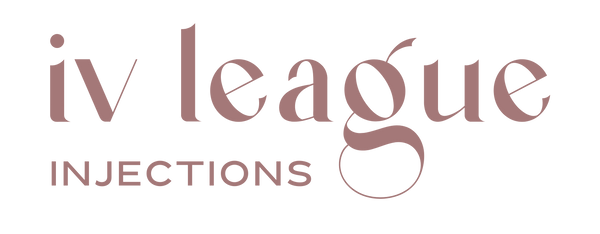
Dermal fillers, also known as soft tissue fillers, are cosmetic injectable products that are used to add volume, smooth out lines, and enhance the contours of the face. In recent years, dermal fillers in Vancouver have become increasingly popular due to their ability to produce natural-looking and long-lasting results. Let us at IV League Injections explain the different types of fillers so that you can make informed decisions before your next cosmetic injections appointment.
What are all the different brands of fillers?
At our cosmetic aesthetics clinic, we carry many different types and brands of dermal fillers which include:
· hyaluronic acid fillers (Revanesse, Stylage, Teoxane and Restylane)
· calcium hydroxyapatite fillers (Radiesse)
· poly-l-lactic acid fillers (Sculptra)
How does the body absorb fillers?
The mechanism by which dermal fillers integrate into the body can be explained by their chemical composition and physical properties. Whether through hydration, coaptation, collagen stimulation, or scaffold formation, dermal fillers provide a safe and effective way to enhance the appearance of the skin and reduce the signs of aging.
What are hyaluronic acid fillers?
Hyaluronic Acid fillers are the most popular and unique in that they are able to integrate into the tissue by attracting and retaining water molecules. This process is known as hydration and helps to create a natural-looking result. The hydration process also stimulates the production of collagen, a protein that provides structure and support to the skin. As a result, the skin becomes fuller and smoother, which helps to reduce the appearance of lines and wrinkles.
The hydration of HA fillers occurs due to the high molecular weight and hydrophilic (water-loving) nature of HA. As the HA particles are injected into the skin, they absorb water and expand, filling in wrinkles, lines, and other areas that need volume restoration. The hydrated HA particles create a matrix that supports the surrounding tissue and provides a foundation for new tissue growth. This is why it is so important to drink water after injections.
In addition to hydration, the process of hydration also stimulates the production of collagen, a protein that provides structure and support to the skin. As a result, the skin becomes stronger and more resilient, which helps to maintain the youthful appearance of the skin over time. It is important to note that the length of time that the HA fillers last can vary depending on a number of factors, including the specific product used, the location of the injection, and the individual's skin type. However, in general, HA fillers can last anywhere from 6 months to 1 year.

What are calcium hydroxyapatite fillers?
Calcium hydroxypatite fillers, on the other hand, are integrated in two ways. One way is thorough a process called capitation. This process occurs when the filler particles adhere to the surrounding tissue and become encased in a layer of collagen. The new tissue formation created by this process helps to support and reinforce the skin, which results in a long-lasting improvement in the appearance of lines and wrinkles.
Calcium hydroxyapatite fillers also integrate into the skin tissue through a process called neocollagenesis. When CaHA is injected into the skin, it stimulates the production of new collagen, which integrates with the surrounding skin tissue and helps to maintain the volume and structure of the treated area. Another term for these fillers are called biostimulators which recruits your own body’s production of collagen. This process can take several months to occur and the results of CaHA filler treatment can last for up to 12-18 months before touch-up treatments may be needed.
What are poly-l-lactic acid fillers?
Poly-L-Lactic fillers are made of a synthetic material another biostimulator that is slowly absorbed by the body over time. As the material is absorbed, it stimulates the production of collagen, which in turn helps to improve the appearance of lines and wrinkles. The final result is a natural-looking and long-lasting improvement in the skin's appearance. When PLLA is injected into the skin, it triggers a foreign-body response, which stimulates the production of new collagen. Over time, the PLLA is absorbed by the body and the new collagen helps to maintain the volume and structure of the treated area. This process can take several months to occur and the results of PLLA filler treatment can last for several months to up to two years, depending on the individual and the specific product used.
Conclusion
Although there are several different types of dermal fillers on the market, you can be rest assured that IV League Injections only carries the safest types of fillers. We also ensure that they are the longest lasting types of fillers so that you can enjoy your results for months or years to come. We want you to be satisfied with your results and will always improve and make any adjustments you need until you are happy. We hope we answered your question of “what are the different types of fillers?” and got you excited in giving non-invasive cosmetic procedures a try. Get in contact with us today and come in for a consultation with one of the best cosmetic injectors in Vancouver!
References:
Alster TS, Tanzi EL. Soft-tissue augmentation with non-surgical injectable fillers. Dermatol Surg. 2006;32(2):271–280.
de Almeida VB, Kim JE, Goldman MP, et al. The Science of Soft Tissue Fillers. Plast Reconstr Surg. 2016;137(6):1793–1804.
Gold MH. Use of hyaluronic acid fillers for the treatment of the aging face. Clin Interv Aging. 2007;2(3):369-76. doi: 10.2147/cia.s1244. PMID: 18044187; PMCID: PMC2685277.
Monheit GD, Alster TS. Soft-tissue augmentation. Facial Plast Surg. 2000;16(2):143–149.
Pavicic T. Calcium hydroxylapatite filler: an overview of safety and tolerability. J Drugs Dermatol. 2013 Sep;12(9):996-1002. PMID: 24002146.
Rivkin R, Fagien S. Soft-tissue augmentation with non-surgical injectable fillers. Facial Plast Surg. 2009;25(4):304–310.
Monheit GD, Alster TS. Soft-tissue augmentation. Facial Plast Surg. 2000;16(2):143–149.
Sickles CK, Nassereddin A, Gross GP. Poly-L-Lactic Acid. [Updated 2022 Jun 7]. In: StatPearls [Internet]. Treasure Island (FL): StatPearls Publishing; 2022 Jan-. Available from: https://www.ncbi.nlm.nih.gov/books/NBK507871/
